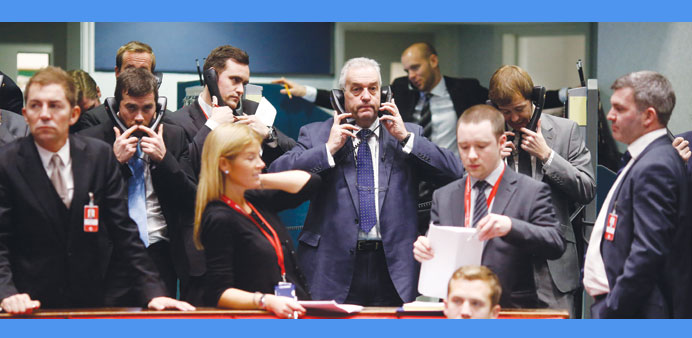Traders use telephones as they work on the trading floor at the London Metal Exchange. Aluminium prices touched a new six-year low of $1,549.50 per tonne on the LME on Tuesday.
By Andy Home /London
Aluminium touched a new six-year low of $1,549.50 per tonne on the London Metal Exchange (LME) on Tuesday.
All part of the ongoing collapse in industrial metal prices as the market collectively downgrades its views on China.
Aluminium’s prospects look particularly bleak given a backdrop of high legacy stocks and structural over capacity in China, which is pumping out ever more surplus metal into the international market in the form of semi-fabricated products.
“Aluminium producers face the longest period of pain in a generation” was how analysts at Goldman Sachs summed up the sector’s prospects in a research note last week. They target a three- and six-month price of $1,500 per tonne and a 12-month price of $1,550 per tonne.
While the bank’s super bearish view of copper attracted much comment from other analysts, no-one has rushed to disagree with its equally gloomy view of aluminium.
But is there a contrarian lurking in the LME spreads? Because someone is holding a mega long position on the LME’s October prompt date.
Spreads have already started tightening and right now it looks as if aluminium is gearing up for one of its sporadic long-short showdowns.
The long position on October is huge, even by the standards of aluminium, the LME’s most liquid contract and a market populated by heavyweight players.
The exchange’s latest futures banding report shows one entity holding a long position greater than 40% of open interest on the October date.
That means it is at least 1.15mn tonnes in size and quite possibly larger.
The report also shows four significant short positions on the same date, all within the 5-10% band. There will be many more smaller shorts out there as well, given the recent steady downtrend.
Money managers are still net long of aluminium, according to the LME’s Commitments of Traders Report. But at 5.3% of open interest that long positioning is close to the bottom end of the range established since the LME first started publishing the report in July last year. Moreover, the LME’s data seems to have an inbuilt long bias when it comes to the money manager category.
An alternative series on “speculative positioning” published by LME broker Marex Spectron shows a net short position of 191,500 lots (4.8mn tonnes), or 29% of open interest, on aluminium. This, it claims, is “the biggest spec short in Ali since August 2012.” Spread tensions are already there.
The October-November spread was valued at $4.50 per tonne backwardation at Tuesday’s close.
That has pulled in the contango across the LME’s benchmark cash-to-three-months period to $27 per tonne, the tightest it’s been since early May.
Quite evidently, this may just be a foretaste of things to come, if that long position holds steady all the way through to October 21. Now, sporadic spread tension has been a regular feature of the aluminium market for many years.
Previous bursts of tightness have as often as not been resolved by mass transfers of metal and a swift easing of spreads back to a level of contango that makes stocks-financing profitable.
It’s a play that is in essence bearish, predicated as it is on metal surplus and a spread structure that incentivises financing and storage of that surplus.
Seen this way, the big October position may not signify a contrarian bull at all, if someone is betting on more surplus metal and a corresponding flexing in the contango structure of the market.
Expected surplus, after all, is why analysts such as Goldman Sachs are forecasting a long period of prices trading into the cost curve. Aluminium is a market with a long track record of over production and slow responsiveness to falling prices.
As Goldman points out, non-Chinese producers have already made the “easy” cuts to their smelter portfolios over the last seven years, while many higher-cost plants in China are being kept afloat by government subsidies.
“If we assume 25% of ex-China production at high risk at current prices was curtailed, it would still be necessary to shut another 2mn tonnes of Chinese supply,” Goldman says, adding, “at this stage, we simply don’t have confidence that this will occur and thus forecast slightly lower prices over the next 12 months.”
* Andy Home is a columnist for Reuters. The opinions expressed are his own.

